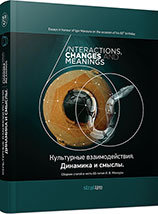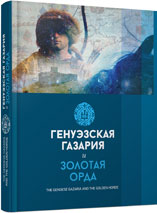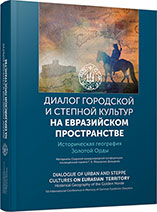
We kindly inform you that, as long as the subject affiliation of our 300.000+ articles is in progress, you might get unsufficient or no results on your third level or second level search. In this case, please broaden your search criteria.


In dem Beitrag wird anhand der einschlägigen Funde dargelegt, daß sich die entscheidenden Innovationen der Metallurgie im 6. und 5. Jahrtausend (der Guß von Kupferobjekten, die Legierung von Metall und der Guß in verlorener Form) weitgehend synchron in einer geographischen Zone zwischen Balutschistan und Balkan vollzogen. Dies wird als das Ergebnis eines raschen Wissenstransfers interpretiert. Anhand frühneuzeitlicher Beispiele werden Aspekte der Spezialisierung und Mobilität von Handwerkern behandelt.
More...
The article studies a Genoese inscription from Soldaia, written in Latin and dated by 1423. In 19th—20th centuries, different scientists, like G. Oderico, P. Keppen, V. Yurgevich, C. Desimoni, E. Skrzinskaya and others have proposed different readings of the inscription. However, an important semantic part of the inscription remained unexplained. One of the factors which made it difficult to decode the inscription was its hardly accessible location.The use of digital photography permitted the author to obtain a qualitative image and to entirely reconstruct the inscription. Basing on its content, the author assumes that G. Catalano, mentioned in the inscription, was not the Genoa’s consul in Soldaia, as thought earlier, but a catholic bishop of the town, who initiated construction of the cathedral. Below the inscription, there are two coats of arms belonging to the Genovese families who provided financial support to the construction. One of these coats of arms was identified as representing the Goano family.
More...
Studies of 14th — 15th cc. complexes on medieval sites in the Crimea (in its southern part mainly) documented presence of three groups of pithoi dated by different periods. The earliest of them were vessels of group I — locally produced thick red clay barrels. By the 15th c. they could have been in use for 500—600 years. One should not exclude possible early medieval traditions of manufacturing such vessels conserved in some regions of Taurica. Imported pithoi of group II became predominant later. They were produced and used for not more than 250—300 years. Further studies must be carried out to identify the region where vessels with such morphological characteristics originated from. The latest to appear were the so called wine jars of group III. They existed for not more than 150—180 years. Their detailed chronology and origin of forms require further investigation.It should be mentioned that the Greek-Byzantine traditional manufacturing and use of pithoi were common in the Crimea in 14th — 15th cc., and most of them seemed to have been used predominantly in wine-making. Relics of these traditions can be still marked in ethnography of peoples living in wine-making regions — Caucasus, Balkans, Pyrenees, etc. However, the Crimea lost these traditions after the Ottoman conquest.
More...
The author introduces glazed pottery found at Saraichik (a Golden Horde Hillfort) and classifies it according to a typology proposed by N. M. Bulatov and G. A. Fedorov-Davydov. Thus, the glazed pottery found at Saraichik is divided into redware and Kashan types.The redware ceramics is further distinguished by the color of glazing: there are vessels with transparent glazing of green, yellow and brown colors, as well as with colorless glazing, and is represented by bowls, plates, jugs, albarello and tubeks. By type of ornament, there are vessels with glazed-over engravings, glazed-over paintings, or a combination of both, as well as pottery with glazed-over stamped ornament on sgraffito.The Kashan ceramics of Saraichik is divided into two groups: with transparent and non-transparent glazing, further divided into subgroups by the color of glazing and method of ornamentation. The Kashan ceramics with colorless glazing and transparent turquoise or ultra-marine glazing was ornamented by glazed-over polychromic painting with glazed-over relief, or painting without relief, while stamped ornament under turquoise glazing is not very common. There are finds of so called ‘Timurid’ ceramics with a specific complex ornament. Besides, there is also ceramics with polychromic painting over ultra-marine glaze (Lajvardina) and ceramics with enamels over white opaque glazing (Minai).Ongoing field research at Saraichik keeps yielding new ceramic artefacts, which demand further detailed and careful studies.
More...
The author focuses on a relation between urbanization and changes in meat consumption among the dwellers of medieval towns in the Middle and Lower Volga area. Methodology elaborated by the Institute of Archaeology of the Russian Academy of Sciences specially for palaeoeconomic reconstructions allowed conducting an archaeozoological study of animal bone collections from archaeological digs on seven urban sites (Bolgarskoe, Uvekskoe, Vodyanskoe, Tzarevskoe, Selitrennoe, Moshaik, Samosdelskoe fortified settlements) in three chronological periods: pre-Mongol, Early Golden Horde and Late Golden Horde. It was established that beef predominated in meat diet of the urban citizens in each of the three periods, followed by mutton and horse meat. Very similar spectrums of meat consumption in almost every town in the mid 14 th c., whenever it emerged or whatever its tradition of meat consumption, expressly demonstrate presence of a well planned agricultural district around them.
More...
The article represents an analysis of the Golden Horde sites situated on the right bank of Lower Volga, which have been large urban settlements in the Middle Ages: Uvekskoe, Vodyanskoe, Mechetnoe fortified settlements, Ternovskoe fortified and open settlements. At the present time these settlements are completely or considerably destroyed, which makes us turn mainly to the research materials from the 19th — early 20th century. Basing on the analysis and correlation of archaeological, numismatic and written sources and urban planning, the author presents the topography of the settlements, main archaeological complexes (fortifications, living and household facilities, burials) and determines the time period and stages in development of these localities.
More...
The author studies sites of Golden Horde time found in the south-eastern part of Ukraine. The nature and climate of this region has three zones: Seversky Donets, Donetsky Kryazh and the Azov region. Different natural environment in these zones conditioned peculiar features of sites located here. In the steppes in Donetsky Kryazh, with their nomad population, the sites represent some barrow necropolises, seasonal camps and some individual finds. The Azov coast, along with sites left by the nomads, yields some stationary settlements, most of which emerged in the second half of 14th c. One of them had an adjacent ground necropolis (Lyapinskaya Balka). The steppe also yields burials of nomad elite, including Muslim ones (the stone from Guselshchikovo). The largest and most typical sites are located in the middle stream of the Seversky Donets (camps, small and large settlements, ground and barrow necropolises). A group of settlements with pseudo Early Russian ceramics had existed there from the previous time period. Next to some of these, some large Golden Horde centers emerge in 14th c. (at village Maiaki and town Raygorodok). It is noteworthy that both groups of settlements coexist in the middle stream of the Seversky Donets during the whole of the Golden Horde time.The rise on the considered territory dates to the second half of 14th c. With the fall of Mamay and accession of Tokhtamysh to power, the region lost its importance. The ultimate desolation of these lands started after the western territories of the Golden Horde had been devastated by Tamerlane in 1395.
More...
In 2012—2015, the Koksharovka-8 burial complex site having no analogy in Primorye medieval archeology was investigated. The remains of a monumental building of rectangular shape, 15 × 16 m built of stone slabs were studied. The design features of the structure and stages of its construction were identified. The studies have shown that a high-ranking nobleman was probably buried there. This is evidenced by both the monumental character of the structure and the nature of the grave goods, including items made of precious metals, most of which were looted by robbers as early as in the Middle Ages. The monument is directly related to the Koksharovka-1 hill fort site, where similar ceramic material has been discovered. Based on the study of the artifacts and radiocarbon analysis data, the burial complex may be tentatively dated to the 10th—11th cc.
More...
The results of the research of hillforts on the territory of Mongolia and the Trans-Baikal (Zabaikalye) region dating back to the time of the Mongol Empire have shown that not all of them can be considered cities. Some of them are palace or manor complexes detached from the settlements. The paper focuses exclusively on sites with undoubted proto-urban or urban status. Among these, first of all, the Karakorum in Mongolia and the Khirkhirin hillfort in the Trans-Baikal region. The history of their research, the features of the sites’ location and layout of urban development, as well as general characteristics of the finds from the cultural layer are reviewed. On the whole, to-date, a large source base about the cities of the Mongol Empire in Mongolia and the Trans-Baikal region has been formed, which allows solving important general problems related to the history and culture of the medieval nomads of Eurasia.
More...
The article systematizes the fragmentary information about the material culture traits, which find parallels in the cities of the Crimea and the Southern Aral region, on the basis of written sources and archeological data. Certain samples of glazed and unglazed pottery have analogies in other Golden Horde sites. The parallels in material culture observed in remote areas are a result of commonalities in cultural achievements of the Golden Horde peoples, rather than just trade relations. In order to study the Crimean-Golden Horde parallels in the Southern Aral region, the evidence of oral historiology was attracted as well.
More...
The Krasnaya Rechka hillfort site, the largest medieval site in Semirechye and the Tien Shan region, was investigated in 2008—2011. In general, the studied complexes are dated back to the second half of the 11th and the 12th centuries. In the upper construction horizon, traces of a strong fire have been recorded. This layer is dated to the early 13th century on the basis of the finds of imported glazed ceramics and Chinese porcelain of the Late Song period. The written accounts make it possible to identify the Krasnaya Rechka hillfort site with Nevaket city and link its collapse to either the destruction by the Kara-Kitai army of Balasagun city (together with its surroundings, to which Krasnaya Rechka hillfort probably belonged) in 1210, or with Genghis Khan’s 1218 campaign.
More...
The author briefly defines history of Kazakhstan medieval urban culture studies and describes early Muslim burial structures studied in the Bozok hillfort site. The method of relative stratigraphy has been instrumental in substantiating the start of the Muslim necropolis formation by the late 13th to early 14th century. The Muslim funerary rite of the Bozok hillfort site reflects peculiarities of the spread of Islam in the peripheral regions of the Ulus of Jochi.
More...
The author discusses the possibility to apply methods of geographic information systems to study development dynamics of a medieval city and uses Bolgar as a case study. The archaeological components allowing reconstructing the dynamics of the urban area are characterized. These components include: the cultural stratum with good stratigraphy, chronological topography of the finds, and distribution of archaeological urban structures. Among the latter, the following items are identified: monumental buildings, urban planning elements (streets, squares, etc.), remains of aboveground dwellings and household structures, remains of dugout dwellings and household structures, fortification objects, industrial and agricultural facilities (furnaces, traces of arable land), burial grounds and hydraulic structures. The research involved drawing of cartograms to represent Bolgar historical and social topography.
More...
A study of aboveground and dugout structures in the excavations territory (100-160 meters to the south-west of the Cathedral Mosque) enabled an attempt to single out urban homestead plots dating to the first half of the 14th century. A complex study of a large area (1912 sq. м), distinction of additional construction horizons within the clearly dated stratigraphic scale of the Bolgar hillfort, identification of the main street, as well as the location of certain dugout structures (cellars) and the study of their content made it possible to produce a spatial organization picture of Bolgar homesteads in the area and to determine the dimensions and space of at least one homestead plot.
More...
The article addresses data on the Bolgar city fortifications in the Golden Horde period. On the basis of archaeological materials, the reconstruction of the defensive structures original appearance is provided. They consisted of wooden walls made up of horizontal and vertical poles, which were installed on an earth rampart. On its external side, there was a ditch, triangular in cross-section. This is the most important evidence that it had not been intended for filling with water being kept always dry. Along the counter-escarp, rows of vertical logs serving as dragon’s teeth have also been revealed. The finds of coins in the base of the defensive rampart date back to its construction during the reign of Jani Beg khan. The material obtained allows offering a new interpretation of the construction period and operation mode of the fortifications in the Golden Horde era.
More...
The authors consider views of the researchers who have studied the fortification of the Bolgar city (the capital of Volga Bulgaria in the 9th to 15th cc.) in the second half of the 20th century. Their conclusions about the “pillar structure” towers above the 14th-century rampart and the wooden walls of similar design are refuted by the data of the excavations conducted by them. The new excavation data revealed that the rampart around Bolgar represented an embankment with the crest lacking any traces of additional defensive structures. It is supposed that their absence is due to the loss of fortification traditions during the rule of the Golden Horde (13th and 14th centuries).
More...
The established opinion of the Russian historiography runs that the border between the Mamai and the Volga Hordes was fixed along the Volga River. A collection of coins dating to the Great Internecine Strife (“velikaya zamyatnya”) period from the Vodyanskoe hillfort site was studied. These data made it possible to conclude that the town on the left-bank Volga area may be related to the Saray region (the Volga Horde domain). Besides, there is a number of indications as to earlier ulus borders along the Don and a minor annalistic evidence concerning an interesting episode in the course of the war between Timur-Khodja and Mamai. All this allows raising the problem of a possible location of the border between the Mamai and the Volga Hordes along the Don River.
More...
Taking into account the polarity of assessments and reconstructions of the 1222 events in the Northern Caucasus, the authors consider both the information of Ali ibn al-Asir and the cartography of prevalence of the Cuman stone sculptures in the region, developed on the basis of works by predecessors (E. D. Felitsyn, T. M. Minaeva). Comparing these data with the list of the latest similar finds, the authors suggest their version of reconstruction of the routes of Mongol-Tatars movement from Derbent across the region, which had eventually brought them to the Kalka River in 1223.
More...
The paper discusses a small collection of 14th—15th-century ceramics from the excavations by the Caucasian archaeological expedition of the State Museum of Oriental Art in Adygeya and the Eastern Black Sea coast of the Caucasus is discussed. Most of the pottery comes from the Shendjiy kurgan cemetery (Adygea) and late medieval burial ground in the village of Kabardinka (near Gelendzhik). Several of the vessels were found on the banks of the Krasnodar Reservoir, where the late medieval funerary sites are situated. The material is divided into two groups: those from the left bank of the Kuban River and from the Black Sea region. The vessels are represented in different forms of jugs and mugs predominantly. All the vessels are made of red clay, which is typical for the Adygeyan ceramics of the Golden Horde period, and are produced on slow rotation potter’s wheel. Most of the jars of the second group have a side drain — a rim in the shape of oenochoe (“towards yourself”), which is a typical feature of the vessels from the Black Sea region. These forms of vessels disappear in the left-bank Kuban region. At the same time, the jugs with tubular drain appear in the ceramic complexes as metal jugs imitations. In general, the ceramic forms represented in the collections of the Museum of the Oriental Art complement the main types of kitchenware, common in the North-Western Caucasus in the 14th—15th centuries.
More...